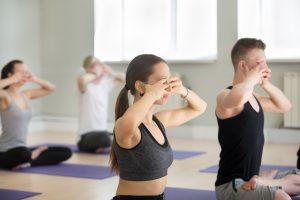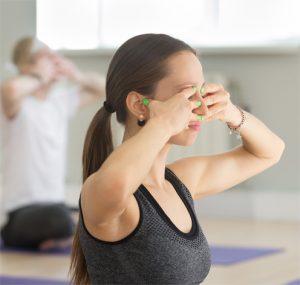By Bernie Clark, June 1st, 2021
You have probably heard the old song from the movie Snow White: Whistle while you work. Well, today we might say: “Hum while you yin.”

Okay, that was a stretch. But, there is a lot of research that shows humming can be very calming and therapeutic, as long as we don’t overdo it. One of the key reasons it has been found to be so effective is the effect humming has on our levels of nitric oxide. Nitric oxide (NO) is an important molecule for heart health, treating diabetes and erectile dysfunction (but, unlike Viagra, no prescriptions are needed to hum and it is free!) NO helps to relax blood vessels, allowing them to dilate and reduce blood pressure.
Given these benefits, it is only natural the people would like to increase their levels of NO, and fortunately, there are several ways to do so. Nutrition can play a key role: eating vegetables like lettuce, spinach, arugula, celery and others which are high in nitrates which the body can convert into NO [1] . Antioxidants like vitamin C and E and polyphenols can increase the lifespan of NO by neutralizing free radicals that can degrade NO. And, of course, exercise! Exercise is known to improve the function of the endothelium (the cells lining our blood vessels) and increase NO production. [2]
But, there is another role for NO: it can help boost our immune function and defend against airborne pathologies such as bacteria, fungi and viruses. NO also stimulates the cilia that line our nasal passages to move gunk stuck in our mucus to the mouth where we can spit it out or swallow it. [3] There is even evidence that NO produced in the nasal passages can reduce the effects of seasonal allergies [4] and reduce heart arrhythmias [5] . So, then the question becomes—how do we increase NO levels in our nose? You can already guess the answer: Hum! [6]

Ommmmmm….with the emphasis on an extended “mmmmm” is a form of humming well known to yogis. Unfortunately, many yoga students try to blast out a long, sustained “Ohhhhhh” when they chant Om. If you want to increase your NO levels, try shortening the “Oh” and elongating the “mmmmm”. Or, you can skip the “Oh” completely and jump straight to the “mmmm”, which is what we do in Bumble Bee Breathing, also called bhramari pranayama. There are many ways to perform bhramari and various mudras can also be employed. [7] The basic practice is very simple and easy: with lips closed make a sound like the drone of a buzzing bee. Not too loud and never with force. Keep all your facial muscle relaxed and make it last as long as you easily can. If you feel weird in any way, dizzy or agitated, stop. When you have finished, don’t rush your breath; allow it to return to normal slowly.
The first photo illustrates a class performing the shanmukhi mudra (the closing of the six gates of perception). This is an option you can add to bhramari pranayama. The position of the fingers helps to close the sense doors and deepen the practice of pratyahara: a going inward. The thumb closes the ears, the index finger lightly touches the inner corner of the eye, the middle finger is on the side of the nose but not pressing it closed (you still need to breathe through the nose!), and the ring finger and little finger are above and below the lips.
Since you can only hum while breathing through the nose, humming forces us to stop breathing through the mouth for a while. Nose breathing has a host of benefits beyond the fact that it promotes production of NO. [8] It slows down our rate of breathing, which by itself helps to improve heart rate variability and exercise tolerance. Nose breathing also helps to turn off our stress system, the sympathetic nervous system and activate the rest system, the parasympathetic nervous system. [9]
How long should we hum for?

Diana Batts, the beloved yin yoga teacher who co-leads our teacher trainings, often offers Bumble Bee Breathing during a yin yoga class. She will invite the students to do 5 breaths while humming like a bee at the end of the opening meditation, while the class is still sitting. This little introduction helps the students learn what humming is like. She will return to the practice for 3 more breaths just before ending an inward-facing posture, like Sphinx Pose with the head dropped down or supported. It can also be done at the end of Shoelace Pose, Square Pose or Child’s Pose. She would not offer it continuously throughout the class, however, as for many students that would be too much breathwork. Diana believes that a hive of bees all humming together brings the class into communion, along with the benefits of focussing attention and vibrating the thyroid gland. [10] I like to end my classes with the hands covering the heart while we chant Om, to help feel the vibration and even enhance it. Often, I may suggest skipping the “Oh” and just do the “mmmm”. This is pure humming.
Jonathan and Andi Goldman, authors of the book The Humming Effect, recommend 5 minutes as a maximum amount of time for humming, followed by 5 minutes of mindful attentiveness and then a short rest before carrying on with your day. But even a single breath done while humming can increase nasal NO by 15 to 30 times! [11] More is not necessarily better and if you start to feel light headed, you definitely should stop. But, you don’t need to be doing yoga to hum. You may find yourself humming through out the day, while preparing meals or washing dishes. Like Snow White sang so long again, “So hum a merry tune…when hearts are high, time will fly.”
___________________________
[1] The nitrates found in vegetables are not the unhealthy forms of nitrates found in preserved meats like hot dogs. The topic is complex and for a much deeper analysis, see Karwowska M, Kononiuk A. Nitrates/Nitrites in Food-Risk for Nitrosative Stress and Benefits. Antioxidants (Basel). 2020;9(3):241. Published 2020 Mar 16. doi:10.3390/antiox9030241.
[2] See Chikara Goto, Kenji Nishioka, Takashi Umemura, Daisuke Jitsuiki, Akihiro Sakagutchi, Mitsutoshi Kawamura, Kazuaki Chayama, Masao Yoshizumi, Yukihito Higashi, Acute Moderate-Intensity Exercise Induces Vasodilation Through an Increase in Nitric Oxide Bioavailiability in Humans: , American Journal of Hypertension, Volume 20, Issue 8, August 2007, Pages 825–830, https://doi.org/10.1016/j.amjhyper.2007.02.014.
[3] Yes “gunk” is a scientific word…actually, no, I’m just kidding, but I always wanted to use the word gunk in an article, so here it is.
[4] Since I started humming every day, I have found that this spring’s allergy season was much milder for me.
[5] Here is a study that describes an anecdotal case of a 66-year-old man who practiced humming for one hour a day. Over four days his chronic rhionsinusitis went away and his irregular heart beats ceases. See Eby GA. Strong humming for one hour daily to terminate chronic rhinosinusitis in four days: a case report and hypothesis for action by stimulation of endogenous nasal nitric oxide production. Med Hypotheses. 2006;66(4):851-4. doi: 10.1016/j.mehy.2005.11.035. Epub 2006 Jan 10. PMID: 16406689.
[6] There are many studies that attest to the effect on NO levels when we hum. For one of the earliest studies see Weitzberg E, Lundberg JO. Humming greatly increases nasal nitric oxide. Am J Respir Crit Care Med. 2002 Jul 15;166(2):144-5. doi: 10.1164/rccm.200202-138BC. PMID: 12119224.
For one of the latest studies which looked at the effect of Bee-Humming breath on heart rate variability and parasympathetic tone, see Ghati N, Killa AK, Sharma G, Karunakaran B, Agarwal A, Mohanty S, Nivethitha L, Siddharthan D, Pandey RM. A randomized trial of the immediate effect of bee-humming breathing exercise on blood pressure and heart rate variability in patients with essential hypertension. Explore (NY). 2020 Apr 28:S1550-8307(20)30116-6. doi: 10.1016/j.explore.2020.03.009. Epub ahead of print. PMID: 32620379.
Interestingly, this study did not find that humming reduced blood pressure, but did improve HRV.
[7] See 5 Ways to Practice Bhramari by Dr. Timothy McCall at Yoga International.
[8] See Alan Ruth, MD, The health benefits of nose breathing in Nursing in general practice, clinical review.
[9] See Bernardi L, Porta C, Gabutti A, Spicuzza L, Sleight P. Modulatory effects of respiration. Auton Neurosci. 2001 Jul 20;90(1-2):47-56. doi: 10.1016/S1566-0702(01)00267-3. PMID: 11485292.
[10] Diana would also play Sonic Guru’s Om Meditation 1, which sounds rather like bumble bee breathing. This background music often inspires some students to hum longer, as they think the whole class is still humming. In general, she will suggest students hum for as long or as short a time as they judge appropriate, but remember—if you feel dizzy, stop.
[11] See Maniscalco M, Weitzberg E, Sundberg J, Sofia M, Lundberg JO. Assessment of nasal and sinus nitric oxide output using single-breath humming exhalations. Eur Respir J. 2003 Aug;22(2):323-9. doi: 10.1183/09031936.03.00017903. PMID: 12952268.
